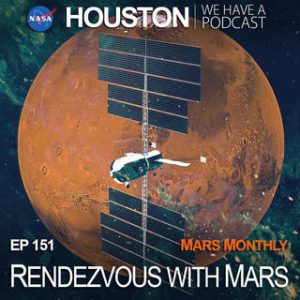What It Takes to Get Us to Mars and Back, featuring Patrick Chai
Fifty years ago, the crew of NASA’s famed Apollo 13 mission ventured to the far side of the moon at an altitude of 158 miles (254 km), placing them 248,655 miles (400,171 km) away from Earth. It’s the farthest our species has ever been from our home planet, for now. Step inside the mind of a rocket scientist; we’re headed to Mars.
Patrick Chai came to NASA Langley Research Center in 2014 as a graduate student at the Georgia Institute of Technology, where he earned his Ph.D. in Aerospace Engineering. While at Langley, Chai gravitated towards systems analysis, which eventually led him to the Space Mission Analysis Brach (SMAB), where he started out as a member of the trajectory analysis team and ultimately moved up to become the lead of Langley’s Mars Architecture Team. Trajectory analysis is a critical portion of the overall mission planning and design, and that excites Chai. When he can break away from his leadership role on the Mars Architecture Team at Langley, Chai still likes to get his hands dirty in the trajectory analysis and mission design work that he enjoys.

“It’s a challenging problem and it is probably one of humanity’s greatest challenges, but I don’t doubt that we can achieve it.”
As an aerospace engineer, Chai is working on the many challenges and unique needs that come into play while considering the difficult task of getting humans to Mars and back. Chai is especially interested in developing different Mars transportation mission concepts and understanding the impacts of various advanced propulsion system options to meet these challenges. Tackling the problem from a systems analysis perspective allows Chai and his team to provide invaluable tools to agency leadership to enable more informed decisions throughout the mission planning process, especially for a mission of such grand magnitude.

Considering that the Moon, located 240,000 miles (385,000 km) on average from Earth, is the furthest humanity has ever traveled, planning for a trip to Mars that could be up to 200 times that distance is a daunting challenge. For us to get to the Moon, it only takes a few days, while getting to Mars could take up to 6-9 months. Shifting the human exploration perspective from an Earth-centric one to a Sun-centric one requires significantly more energy, meticulous planning, and exact timing. How meticulous and exact, you might ask? For the uninitiated, Chai explains the challenge of designing a mission to Mars with a simple thought experiment. Imagine that the Earth and Mars are railcars on separate train tracks that are circling around the Sun millions of miles apart and moving at speeds tens of thousands of miles per hour. Now imagine that you’re standing on one of the trains, and your job is to throw an egg across the distance and have it land on the other train without breaking. That’s the mission to Mars in an eggshell. “Not only do you have to have enough energy to throw the egg so that it reaches the destination, you also need to have propulsive energy to slow the egg down so that it doesn’t break when it reaches the destination,” explains Chai. As for the timing of it all, Chai’s mission planning has to wait for the trains to align in the proper orientation to maximize the use of the train’s velocity (the speed and direction) to minimize the energy that is required to achieve the biggest egg toss in history. Simply put, timing is key.
“Typically, the Earth/Mars synodic cycle is about 26 months, so every 26-ish months, you get one of those [minimum energy] opportunities,” says Chai. These types of minimal energy trajectories have been used for many robotic missions, like with the Mars 2020 Perseverance rover. However, these minimal energy trajectories take a very long time. In the near future, unlike with previous Mars missions, astronauts will be on board. The goal is to get the astronauts to Mars and back to Earth safely and efficiently, which drives round-trip mission planning and puts constraints on how long these missions can last. The current goal for NASA is to send humans to the fourth planet as early as the 2030s. For the case where a minimal energy trajectory is used for both legs of the trip, a round-trip to Mars will take an average of 3 to 3.5 years total. Once you get to Mars, Chai says, “You stay on the surface [or in orbit] for 300 to 500 days just waiting for the planet to realign so you can come back to Earth on the same low minimum energy trajectory.” However, as new advanced propulsion technologies are developed, that timeline could be contracted to reduce the human exposure to deep space. The Mars exploration mission involves not only the trajectory analysis, but thousands of other variables and considerations, and Chai and his team need to be ready to tackle them all.
“It’s a very exciting time for NASA,” says Chai. There are many challenges with rendezvousing with Mars. It is hard work, but Patrick Chai and his team at NASA Langley and across the agency are up for it. “It’s a challenging problem and it is probably one of humanity’s greatest challenges, but I don’t doubt that we can achieve it,” says an optimistic Chai.

This article was adapted from Episode 151 of “Houston We Have a Podcast”, the official podcast of the NASA Johnson Space Center. This episode was recorded on February 4, 2020.
The full episode can be found here: https://www.nasa.gov/johnson/HWHAP/rendezvous-with-mars
Edited by: John Baldridge
Contact: Emily Judd
Published: October 2020









